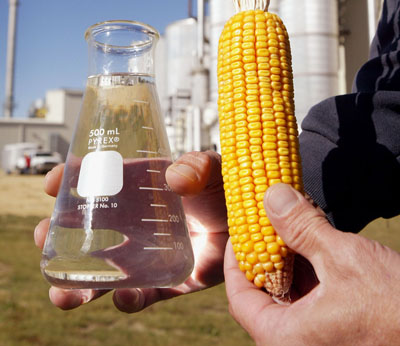Back To Chemicals
Page <<



Cellulosic Ethanol
While ethanol
is typically produced from the starch contained in grains such
as corn and grain sorghum, it can also be produced from
cellulose. Cellulose is the main component of plant cell walls
and is the most common organic compound on earth. It is more
difficult to break down cellulose to convert it into usable
sugars for ethanol production. Yet, making ethanol from
cellulose dramatically expands the types and amount of available
material for ethanol production. This includes many materials
now regarded as wastes requiring disposal, as well as corn
stalks, rice straw and wood chips or "energy crops" of
fast-growing trees and grasses.
Producing ethanol from
cellulose promises to greatly increase the volume of
fuel ethanol that can be produced in the U.S. and
abroad. A recent report found the land resources in the U.S. are
capable of producing a sustainable supply of 1.3 billion tons
per year of biomass, and that 1 billion tons of biomass would be
sufficient to displace 30 percent or more of the country's
present petroleum consumption.
Importantly, it
offers tremendous opportunities for new jobs and economic growth
outside the traditional "grain belt," with production across the
country from locally available resources. Cellulose ethanol
production will also provide additional greenhouse gas emissions
reductions.
The Energy
Policy Act of 2005 (H.R. 6), signed into law in August 2005,
contains a number of incentives designed to spur cellulosic
ethanol production:
- Creates a credit-trading program where 1 gallon of cellulosic
biomass ethanol or waste derived ethanol is equal to 2.5 gallons
of renewable fuel
- Creates a cellulosic biomass program of 250 million gallons in
2013
- Creates a Loan Guarantee Program of $250 million per facility
- Creates a $650 million Grant Program for cellulosic ethanol
- Creates an Advanced Biofuels Technologies Program of $550
million.
- Targets Biomass Research and Development
- Establishes program of production incentives to deliver the
first billion gallons of annual cellulosic ethanol production
|
 Note:
These API/ chemicals are designated as those that are used in
the manufacture of the controlled substances and are important to
the manufacture of the substances. For any (Control Substance)
products Import and Export *** subjected to your country government
laws /control substance ACT. Note:
These API/ chemicals are designated as those that are used in
the manufacture of the controlled substances and are important to
the manufacture of the substances. For any (Control Substance)
products Import and Export *** subjected to your country government
laws /control substance ACT.
Note /Government Notification: N/A
New Chemicals
Phenyl acetic acid,
3,4-methylenedioxyphenyl-2-propanone,
Piperidine and its salts,
Methylamine,
Propionic anhydride,
Para Methoxy Phenyl Acetone,Para Methoxy Phenyl Acetic Acid,
Benzene,
Benzyl methyl ketone,
3'-Aminoacetophenone,
Ethylamine,
I sosafrole,
Piperonal,
N-methylpseudoephedrine sosafrole,
Piperonal,
N-methylpseudoephedrine
|
|

World production of ethanol in 2006 was 51 gigalitres (1.3×10 US
gal), with 69% of the world supply coming from Brazil and the
United States.
More than 20% of Brazilian cars are able to use 100% ethanol as
fuel, which includes ethanol-only engines and
flex-fuel engines. Flex-fuel engines in Brazil are able to
work with all ethanol, all gasoline or any mixture of both. In
the US flex-fuel vehicles can run on 0% to 85% ethanol (15%
gasoline) since higher ethanol blends are not yet allowed

or efficient. Brazil supports this population of ethanol-burning
automobiles with large national infrastructure that produces
ethanol from domestically grown sugar cane.
Sugar cane not only has a greater concentration of sucrose
than corn (by about 30%), but is also much easier to extract.
The bagasse generated by the process is not wasted, but is used
in power plants as a surprisingly efficient fuel to produce
electricity. |
|


